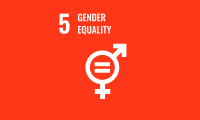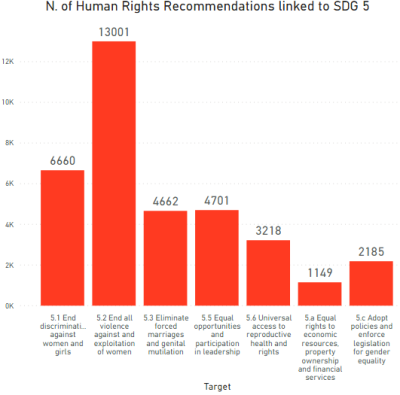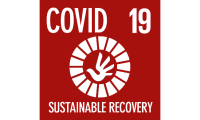SDG 5 and Sustainable Recovery

Key aspects of SDG 5:
1. Eliminate discrimination and violence against women and girls (targets 5.1, 5.2)
Discrimination against women and girls is at the root of gender-based violence. The COVID-19 crisis has deepened gender inequalities as the burden of caring for children at home and for sick or older family members has fallen disproportionately on women, with gender stereotypes still deeply embedded in many societies. This is exacerbated for single working mothers who face intersecting systems of discrimination and disenfranchisement.
COVID-19 related quarantine and isolation policies, coupled with financial stress on families, individuals and communities have resulted in an increase in domestic and gender-based violence. Many women are forced to stay at home with their abusers while services that support survivors are being disrupted or made inaccessible. School closures put adolescent girls at increased risk of different forms of abuse including early and forced marriages, adolescent pregnancy and sexual abuse.
The negative impacts of the pandemic on women are further amplified in contexts of fragility, conflict, and emergencies where social cohesion is already undermined and institutional capacity and services are limited.
Sustainable response and recovery actions:
It is important for national response and recovery plans to prioritize support for women and girls by implementing measures that have proven to be effective. These include but are not limited to:
Integrating prevention efforts and services to respond to violence against women in COVID-19 response plans; designating domestic violence shelters as essential services and increasing resources to them, and to civil society groups on the frontline of response; expanding the capacity of shelters for victims of violence by repurposing other spaces, such as empty hotels or education institutions, to accommodate quarantine needs, and integrating considerations of accessibility for all; designating safe spaces for women where they can report abuse without alerting perpetrators, for example in grocery stores or pharmacies; moving services online; stepping up advocacy and awareness campaigns, including targeting men at home.
Visit the documents and resources listed in the “Key Human Rights Guidance” below for more information.
Universal Declaration of Human Rights (UDHR), art. 3: Everyone has the right to life, liberty and security of person.
International Covenant on Civil and Political Rights (ICCPR), art. 7: No one shall be subjected to torture or to cruel, inhuman or degrading treatment or punishment. In particular, no one shall be subjected without his free consent to medical or scientific experimentation.
Convention on the Elimination of all Forms of Discrimination Against Women (CEDAW), art. 2: “States Parties condemn discrimination against women in all its forms, agree to pursue by all appropriate means and without delay a policy of eliminating discrimination against women and, to this end, undertake:
2.a. To embody the principle of the equality of men and women in their national constitutions or other appropriate legislation if not yet incorporated therein and to ensure, through law and other appropriate means, the practical realization of this principle;
2.b. To adopt appropriate legislative and other measures, including sanctions where appropriate, prohibiting all discrimination against women;
Convention on the Elimination of all Forms of Discrimination Against Women (CEDAW), art. 3: States Parties shall take in all fields, in particular in the political, social, economic and cultural fields, all appropriate measures, including legislation, to ensure the full development and advancement of women , for the purpose of guaranteeing them the exercise and enjoyment of human rights and fundamental freedoms on a basis of equality with men.
Convention on the Rights of the Child (CRC), art. 19.1: States Parties shall take all appropriate legislative, administrative, social and educational measures to protect the child from all forms of physical or mental violence, injury or abuse, neglect or negligent treatment, maltreatment or exploitation, including sexual abuse, while in the care of parent(s), legal guardian(s) or any other person who has the care of the child.
2. Ensure women’s full and effective participation, equal opportunities for leadership, and enhance use of enabling technology to promote empowerment of women (targets 5.5, 5.b)
The pandemic has disproportionately affected women and their full and effective participation in society in multiple ways. For example, female job loss rates far exceed male job loss rates globally; unpaid care work has exponentially increased as has violence against women. 70% of the workers in health and social sectors worldwide consist of women, placing them in the frontline of the pandemic and exposing them to further risk. Altogether, this has led to a major setback for gender equality globally.
The COVID-19 pandemic has made the world rapidly more digital as learning, work, and public services including critical health information moved online in many parts of the world. This has also deepened the digital divide, further leaving behind those without digital access.
The digital divide disproportionately affects women as large gender gaps persist in most of the world regarding internet access and use (17% global internet user gender gap). This, among many other factors, prevents women from effectively exercising their rights to participation and to freedom of expression.
Before the pandemic women held less than 25% of seats in parliament in high, medium and low development groups. The pandemic and following lockdown have pulled many women back to the household chores, and further hindered them in participating in decision-making, leading to widening gender gaps in accessing basic services, controlling assets and managing resources.
Sustainable response and recovery actions:
It is crucial that all national response and recovery plans place the inclusion, representation, rights, social and economic outcomes, equality and protection of women and girls at the centre. Women's equal representation in all response and recovery planning and decision-making must be ensured - from company boards to parliaments, from higher education to public institutions. Targeted measures, including quotas, must be deployed to address the socio-economic impacts and to achieve greater gender equality.
Nations must ensure the economic inclusion of women trough equal pay, targeted credit, job protection and significant investments in the care economy and social protection. Furthermore, nations must enact an emergency response plan to address violence against women and girls, and follow through with funding, policies, and political will.
Investments must be made in closing the digital gender divide and ensuring equal access to information and communication technology. Education of women and girls must empower them to participate and lead.
Visit the documents and resources listed in the “Key Human Rights Guidance” below for more information.
Universal Declaration of Human Rights (UDHR), art. 19: Everyone has the right to freedom of opinion and expression; this right includes freedom to hold opinions without interference and to seek, receive and impart information and ideas through any media and regardless of frontiers.
Universal Declaration of Human Rights (UDHR), art. 27.1: Everyone has the right freely to participate in the cultural life of the community, to enjoy the arts and to share in scientific advancement and its benefits.
Convention on the Elimination of all Forms of Discrimination Against Women (CEDAW), art. 7.b: States Parties shall take all appropriate measures to eliminate discrimination against women in the political and public life of the country and, in particular, shall ensure to women, on equal terms with men, the right: (b) To participate in the formulation of government policy and the implementation thereof and to hold public office and perform all public functions at all levels of government.
Convention on the Elimination of all Forms of Discrimination Against Women (CEDAW), art. 7.c: States Parties shall take all appropriate measures to eliminate discrimination against women in the political and public life of the country and, in particular, shall ensure to women, on equal terms with men, the right: (c) To participate in non-governmental organizations and associations concerned with the public and political life of the country.
3. Recognize unpaid care and domestic work through the provision of public services, infrastructure and social protection policies (target 5.4)
Women have faced an exponential increase in the amount of unpaid care work as a result of the pandemic. As women take on greater care demands at home, their jobs are disproportionately affected by cuts and lay-offs. The COVID-19 global recession will likely result in a prolonged dip in women’s incomes and labour force participation, with compounded impacts for women already living in poverty.
The situation is worse in developing economies where the vast majority of women’s employment (70%) is in the informal economy with limited protection against dismissal and limited access to social protection and paid sick leave.
In the formal economy, care jobs, including teachers and nurses, are underpaid in relation to other sectors. At home, women perform the bulk of care work, which is unpaid and invisible. Both are foundational to daily life and the economy but are premised on and entrench gendered norms and inequalities.
Sustainable response and recovery actions:
It is important to apply an intentional gender lens to the design of fiscal stimulus packages and social assistance programmes to achieve greater equality, opportunities, and social protection. Measures can include for example establishing or scaling up cash transfer programmes which reach both women and men, expanded leave policies, unemployment benefits, pensions or child grants.
Sustainable recovery will have to involve transformative change to address the care economy, paid and unpaid, to ensure gender equality and pay equity.
Visit the documents and resources listed in the “Key Human Rights Guidance” below for more information.
International Covenant on Economic, Social and Cultural Rights (ICESCR), art. 7: The States Parties to the present Covenant recognize the right of everyone to the enjoyment of just and favourable conditions of work.
International Covenant on Economic, Social and Cultural Rights (ICESCR), art. 9: The States Parties to the present Covenant recognize the right of everyone to social security, including social insurance.
Convention on the Elimination of all Forms of Discrimination Against Women (CEDAW), art. 14.1: States Parties shall take into account the particular problems faced by rural women and the significant roles which rural women play in the economic survival of their families, including their work in the non-monetized sectors of the economy, and shall take all appropriate measures to ensure the application of the provisions of the present Convention to women in rural areas.
International Labour Organisation (ILO) (C156) Workers with Family Responsibilities Convention, art. 3: With a view to creating effective equality of opportunity and treatment for men and women workers, each Member shall make it an aim of national policy to enable persons with family responsibilities who are engaged or wish to engage in employment to exercise their right to do so without being subject to discrimination and, to the extent possible, without conflict between their employment and family responsibilities.
Key Human Rights Guidance:
- COVID-19 and women’s human rights, The Office of the High Commissioner for Human Rights (OHCHR), Guidance, 2020
- COVID-19 and the human rights of LGBT people, The Office of the High Commissioner for Human Rights (OHCHR), Guidance, 2020
- ASPIRE Guidelines on COVID-19 response and recovery free from violence and discrimination based on sexual orientation and gender identity, Independent Expert on protection against violence and discrimination based on sexual orientation and gender identity / Special Procedures, 2020
- The impact and consequences of the COVID-19 pandemic on trafficked and exploited persons, Special Rapporteur on trafficking in persons, especially women and children / Special Procedures, COVID-19 Position paper, 2020
- CEDAW and COVID-19, Committee on the Elimination of Discrimination against Women (CEDAW), Guidance Note, 2020
- Call for joint action in the times of COVID-19, Committee on the Elimination of Discrimination against Women (CEDAW), Statement, 2020
- The economic impacts of COVID-19 and gender inequality recommendations for policymakers, United Nations Development Programme (UNDP), Briefing Note, 2020
- COVID-19: A Gender Lens. Protecting Sexual and Reproductive Health and Rights, and Promoting Gender Equality, United Nations Population Fund (UNFPA), Technical Brief, 2020
- COVID-19 and Ending Violence Against Women and Girls, UN Women, Brief, 2020
- Equality of rights between men and women, General Comment, No. 28 Art. 3 (CCPR/C/21/Rev.1/Add.10), Covenant on Civil and Political Rights (CCPR), 2000
- Equal right of men and women to the enjoyment of all economic, social and cultural rights, Committee on Economic, Social and Cultural Rights (CESCR), General Comment, No. 16 (E/C.12/2005/4), 2005
- The Impact of COVID-19 on Women, United Nations, Policy Brief, 2020
- Right of the child to freedom from all forms of violence, Committee on the Rights of the Child (CRC), General Comment, No. 13 (CRC/C/GC/13), 2011
- Recommendations from human rights monitoring mechanisms linked to SDG 5 by country, Danish Institute for Human Rights, search page
- Human rights law and standards linked to SDG 5 by target, Danish Institute for Human Rights, search page
- Observations by ILO supervisory bodies on the ILO instruments (by convention and by country), International Labour Organisation (ILO), search page
- Resources and cases on gender discrimination, Danish Institute for Human Rights, website


